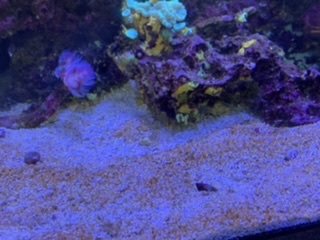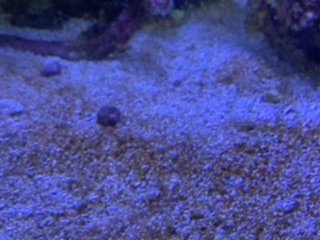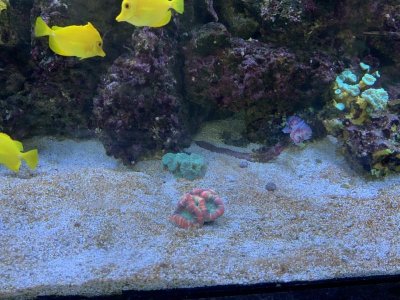I am reaching out for help. I have had a brown growth that appears on my sand and on a few rocks. I have vacuumed the sand and it improves but comes back each time. My tank has been up and running for 1.5 years, but the rocks i used were from a previous tank. Things look good in the tank with the exception of the ?brown algae that forms on the sand and glass. When I scrape it off the glass the tangs eat it. My parameters are phosphate-0.00, nitrite-0.004, calcium 415, and alk-139ppm. Salinity is 1.025.
You are using an out of date browser. It may not display this or other websites correctly.
You should upgrade or use an alternative browser.
You should upgrade or use an alternative browser.
Brown algae? Diatoms? Dinoflagellates?
- Thread starter mhsmith
- Start date
It's hard to tell from the pictures. Diatoms have a hard shell, and don't form a gel the way that dinoflagellates will. Also, a number of snail species, including Trochus, will eat diatoms. Getting something to eat dinoflagellates can be harder. I don't know that the tangs are very picky. I never kept a tang.
Looks like diatoms to me. Does not look to be putting out bubbles, like dinos do. Fighting Conches are good sand bed cleaners.
B
bozoreefer
Could it be that his redfield ratio is off?
Sent from my SM-G955U using Tapatalk
Sent from my SM-G955U using Tapatalk
what do you mean by redfield ratio? I don't know what that is. I was reluctant when I got the new tank to get a huge clean up crew, but that is probably a good idea. Any suggestions as to where to purchase. In the past I used reef cleaners, but they sent a lot of tiny snail and I am not sure how functional they were.
The Redfield Ratio refers to the ratio of macro nutrients (Carbon/Nitrogen/Phosphorus) used by phytoplankton, which corals consume. Hitting that ratio (106:16:1), is the goal of some reefers.
An ideal clean up crew isn't huge, but starts out small, then reproduces to the numbers needed to match algae growth. Reproducing snails fit the bill. Check out Cerith and Mini Strombus snails, which will reproduce for you.
An ideal clean up crew isn't huge, but starts out small, then reproduces to the numbers needed to match algae growth. Reproducing snails fit the bill. Check out Cerith and Mini Strombus snails, which will reproduce for you.
You would test your water for CO2, total Nitrogen, and phosphate (I think).
I like Gulf Coast Ecosystems (live-plants.com) and Indo-Pacific Sea Farms (ipsf.com).
I like Gulf Coast Ecosystems (live-plants.com) and Indo-Pacific Sea Farms (ipsf.com).
My pleasure, cheers!
B
bozoreefer
The n p balance is irrelevant in our tanks?The Redfield Ratio doesn't mean anything in our tanks. I would concentrate on adding a few snails to eat the diatoms. I have had good experiences with ipsa.com, as well. A local fish store might have some cerith snails available, though.
I see people dosing no3 or po4 depending on what they lack just so they can diminish cyano
Sent from my SM-G955U using Tapatalk
coralcruze2020
Member
looks like brown cyano backteria...
Similar threads
- Replies
- 7
- Views
- 594



